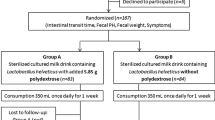Abstract
E. coli strain Nissle 1917 (EcN) is a probiotic clinically used with various indications. However, especially at the beginning of treatment, some patients report abdominal bloating. In a prospective, randomized, double-blind study in 30 healthy individuals we assessed the influences of EcN on intestinal gas dynamics and abdominal sensation. After one week without medication volunteers orally received 2.5–25 × 109 colony-forming units of EcN or placebo per day for 21 days. EcN was well tolerated and did not significantly affect abdominal symptoms, stool frequency or stool consistency. During gas challenge at different days no difference in the perception scores (range from 0 = no perception to 6 = pain) was observed between the two groups: the mean perception score was 1.2 (SD 0.2) in the EcN group and 1.4 (SD 0.2) in the placebo group. EcN had no relevant influence on intestinal gas dynamics.





Similar content being viewed by others
Abbreviations
- CFU:
-
Colony-forming unit
- EcN:
-
Escherichia coli strain Nissle 1917
- SF6 :
-
Sulfurhexafluoride
References
Guarner F, Malagelada JR (2003) Gut flora in health and disease. Lancet 361:512–519
Schrezenmeir J, de Vrese M (2001) Probiotics, prebiotics, and synbiotics—approaching a definition. Am J Clin Nutr 73:361S–364S
Gionchetti P, Lammers KM, Rizzello F, Campieri M (2005) VSL#3: an analysis of basic and clinical contributions in probiotic therapeutics. Gastroenterol Clin North Am 34:499–513, ix-x
Gionchetti P, Rizzello F, Lammers KM, Morselli C, Sollazzi L, Davies S, Tambasco R, Calabrese C, Campieri M (2006) Antibiotics and probiotics in treatment of inflammatory bowel disease. World J Gastroenterol 12:3306–3313
Kruis W, Fric P, Pokrotnieks J, Lukas M, Fixa B, Kascak M, Kamm MA, Weismueller J, Beglinger C, Stolte M, Wolff C, Schulze J (2004) Maintaining remission of ulcerative colitis with the probiotic Escherichia coli Nissle 1917 is as effective as with standard mesalazine. Gut 53:1617–1623
Resta-Lenert S, Barrett KE (2003) Live probiotics protect intestinal epithelial cells from the effects of infection with enteroinvasive Escherichia coli (EIEC). Gut 52:988–997
Seksik P, Marteau P (2004) Probiotics in inflammatory bowel disease: controlled trials and perspectives. Therapie 59:83–87
Vanderhoof JA (2000) Probiotics and intestinal inflammatory disorders in infants and children. J Pediatr Gastroenterol Nutr 30(Suppl 2):S34–S38
Blum G, Marre R, Hacker J (1995) Properties of Escherichia coli strains of serotype O6. Infection 23:234–236
Kruis W, Schutz E, Fric P, Fixa B, Judmaier G, Stolte M (1997) Double-blind comparison of an oral Escherichia coli preparation and mesalazine in maintaining remission of ulcerative colitis. Aliment Pharmacol Ther 11:853–858
Rembacken BJ, Snelling AM, Hawkey PM, Chalmers DM, Axon AT (1999) Non-pathogenic Escherichia coli versus mesalazine for the treatment of ulcerative colitis: a randomised trial. Lancet 354:635–639
Henker J, Blokhin B, Bolbot YK, Maydannik VG, Jores L, Wolff C, Schulze J (1917) Successfull therapy of unspecific prolonged diarhoea in infants, toddlers with the probiotic E. coli strain Nissle Gastroenterology 130(4):A-315
Henker J, Laass M, Blokhin BM, Bolbot YK, Maydannik VG, Elze M, Wolff C, Schulze J (2007) The probiotic Escherichia coli strain Nissle 1917 (EcN) stops acute diarrhoea in infants and toddlers. Eur J Pediatr 166:311–318
Krammer HJ, Kamper H, von Bunau R, Zieseniss E, Stange C, Schlieger F, Clever I, Schulze J (2006) Probiotic drug therapy with E. coli strain Nissle 1917 (EcN): results of a prospective study of the records of 3807 patients. Z Gastroenterol 44:651–656
Serra J, Azpiroz F, Malagelada JR (1998) Intestinal gas dynamics and tolerance in humans. Gastroenterology 115:542–550
Kim HJ, Camilleri M, McKinzie S, Lempke MB, Burton DD, Thomforde GM, Zinsmeister AR (2003) A randomized controlled trial of a probiotic, VSL#3, on gut transit and symptoms in diarrhoea-predominant irritable bowel syndrome. Aliment Pharmacol Ther 17:895–904
Nobaek S, Johansson ML, Molin G, Ahrne S, Jeppsson B (2000) Alteration of intestinal microflora is associated with reduction in abdominal bloating and pain in patients with irritable bowel syndrome. Am J Gastroenterol 95:1231–1238
Mollenbrink M, Bruckschen E (1994) Treatment of chronic constipation with physiologic Escherichia coli bacteria. Results of a clinical study of the effectiveness and tolerance of microbiological therapy with the E. coli Nissle 1917 strain (Mutaflor). Med Klin (Munich) 89:587–593
Levitt MD, Furne J, Olsson S (1996) The relation of passage of gas and abdominal bloating to colonic gas production. Ann Intern Med 124:422–424
Niedzielin K, Kordecki H, Birkenfeld B (2001) A controlled, double-blind, randomized study on the efficacy of Lactobacillus plantarum 299V in patients with irritable bowel syndrome. Eur J Gastroenterol Hepatol 13:1143–1147
Serra J, Azpiroz F, Malagelada JR (2001) Mechanisms of intestinal gas retention in humans: impaired propulsion versus obstructed evacuation. Am J Physiol Gastrointest Liver Physiol 281:G138–G143
Serra J, Azpiroz F, Malagelada JR (2001) Impaired transit and tolerance of intestinal gas in the irritable bowel syndrome. Gut 48:14–19
Harder H, Serra J, Azpiroz F, Passos MC, Aguade S, Malagelada JR (2003) Intestinal gas distribution determines abdominal symptoms. Gut 52:1708–1713
Harder H, Serra J, Azpiroz F, Malagelada JR (2004) Reflex control of intestinal gas dynamics and tolerance in humans. Am J Physiol Gastrointest Liver Physiol 286:G89–G94
Houghton LA, Lea R, Agrawal A, Reilly B, Whorwell PJ (2006) Relationship of abdominal bloating to distention in irritable bowel syndrome and effect of bowel habit. Gastroenterology 131:1003–1010
Azpiroz F, Malagelada JR (2005) The pathogenesis of bloating and visible distension in irritable bowel syndrome. Gastroenterol Clin North Am 34:257–269
Azpiroz F, Malagelada JR (2005) Abdominal bloating. Gastroenterology 129:1060–1078
Azpiroz F, Serra J (2004) Treatment of excessive intestinal gas. Curr Treat Options Gastroenterol 7:299–305
Levitt MD (1975) Intestinal gas. Postgrad Med 57:77–81
Acknowledgement
Grant support was received from Ardeypharm, Herdecke, Germany. The authors would like to thank all volunteers enrolled for their commitment to the study and their patience connected to the examinations.
Author information
Authors and Affiliations
Corresponding author
Rights and permissions
About this article
Cite this article
Hernando-Harder, A.C., von Bünau, R., Nadarajah, M. et al. Influence of E. coli Strain Nissle 1917 (EcN) on Intestinal Gas Dynamics and Abdominal Sensation. Dig Dis Sci 53, 443–450 (2008). https://doi.org/10.1007/s10620-007-9892-3
Received:
Accepted:
Published:
Issue Date:
DOI: https://doi.org/10.1007/s10620-007-9892-3




